With that said, let's do a clockwise turn around the garden, starting at the back doorstep...
 This is currently the brightest spot in the garden: a pot of Nemesia that I got for free at P. Allen Smith's seminar at the San Francisco Flower Show last month.
This is currently the brightest spot in the garden: a pot of Nemesia that I got for free at P. Allen Smith's seminar at the San Francisco Flower Show last month.Right next to that is BH's garden, a little memorial garden-in-progress for my late, great cat. This picture was taken a few days ago, but now the Bleeding Hearts in the back are almost ready to bloom. I'm planning on putting in catnip and Forget-Me-Nots as well.
Next, we come to one of my problem children: a passion flower vine that doesn't seem to be happy no matter where I put it. Last month I moved it here, which is the sunniest spot I've got to offer it. I'm starting to feel like this pathetic little passion is a reflection of my romantic history. I seem to spend most of my time standing in front of it imploring, "Just tell me what you want!"
And oh, yes, there are a few weeds. Well, more than a few...
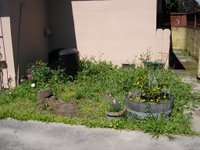 This spot is where I intend to plant veggies this year, possibly trying the lasagna method.
This spot is where I intend to plant veggies this year, possibly trying the lasagna method.
And by this time next month, I hope to have this next area on the side of the house set up as a propagation area. The recycling bin will also get relocated here.
This side bed may look innocent enough, but lurking just below the surface are hundreds of small tubers resulting from the Four O'Clocks I planted two years ago. I really need to get them dug up and donated to unsuspecting gardeners who don't know that they will reproduce like rabbits. Once they're cleared, I'm planting a brugmansia that I'm starting from a cutting and some liriope that I have waiting in 4-inch pots.
Next comes my shed and deck, which could definitely use some sprucing up.
And in front of the deck is an odd, little rectangular bed. It was laid with sod when I moved in, but since I happily tore that out, I've had good luck with lettuce and spinach, and more recently, strawberries here. The stick-like thing in the big pot in the middle is a dwarf Ranier Cherry. After I bought it, I learned that I need to get it a boyfriend cherry tree if I ever want it to fruit.
An no, that's not snow on the ground in the middle of the bed. It's the remnants of the shredded office paper I tried out as mulch last year. The pots in the foreground are three lavendar starts and about 22 Ogallala strawberries I got a few weeks ago from Gurney's.
Next is the L-shaped bed that runs around the western corner of my lot. Along the back fence are iris, daffodils, papyrus, a volunteer calla lilly, some delphiniums, nasturtiums, and a few primroses. In the corner is a lilac that I planted in February (bought bare-root from Smith & Hawken). Then along the side fence are a couple more delphinium, three roses (two of which are from my grandmother's garden), and an apricot hibiscus.
Last but not least, there's a wonderful jasmine climbing up an invisible trellis on the side of the carport. Some irises have made a tentative appearance below it, amongst the weeds.
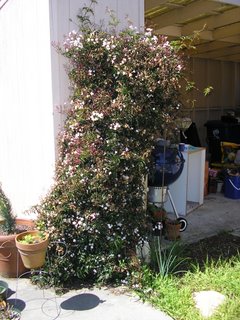 As you can also glimpse here, the clutter in the carport has gotten out of control. Soon to be dealt with, though.
As you can also glimpse here, the clutter in the carport has gotten out of control. Soon to be dealt with, though.
And here we are, back again at the back door. My mustached cat, Linus, is peeking out to say good-bye.

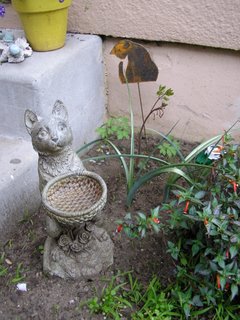
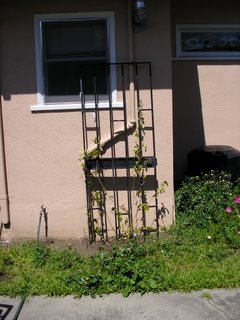
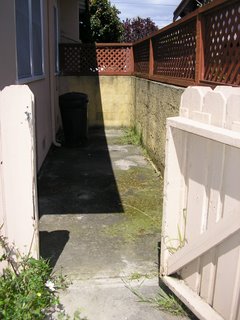
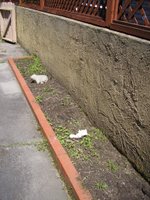

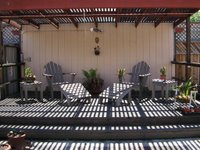

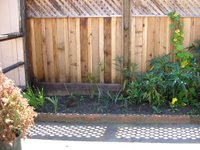


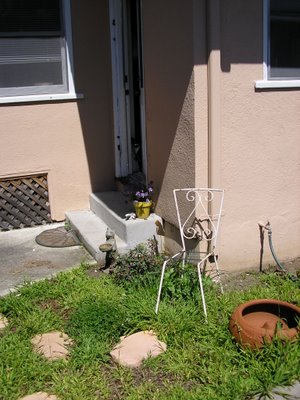
I think you just need to get out there & water everything real well
ReplyDeleteHi Claire. I very much enjoyed having you share your garden - it will be fun to watch it evolve and revolve through the seasons. My ears pricked up when you mentioned passionflowers, as I was a volunteer grower of them and many other vines at Strybing Arboretum in SF.
ReplyDeleteYour plant looks to be doing fine so allow me to add to your knowledge of them. They like to have a sizeable root mass before they bloom, whether they are in a container or in the ground. Let your plant get settled in its location, keep it well watered and give it time to become established. Once they are in the ground they do not require a great deal of fertilizer. A little organic slow release is beneficial but try not to tempt them with a lot of liquid feed – you’ll have too much foliage and not enough flowers. Vines flower best when they are trained horizontally and like to grow and grow when their stems are vertical. When your plant reaches the top of its trellis let the stems arc and hang over and when they seem too long train them back up through the trellis. The plant will perceive that its leader is gone and will send out many new shoots – your plant will become fuller and you will have more flowers.
Most passionflower flowers only last a day so enjoy them when you see them – cut some and float them in a bowl, you will be surprised how fragrant many of them can be. While you have them up close, notice how the filaments are arranged in a series of rings around the flower. Also notice that at least one of the spaces between the rings is filled with nectar – hummingbird gold!
If you look closely at the stems and leaves you will notice small gold or orange bumps. The plants produce them to fool butterflies into thinking eggs are already on the plant so please don’t bother them. But the large orange gulf fritillary butterfly isn’t fooled and will lay its eggs. These hatch out into hideous orange and black spiky caterpillars but if you leave them be you will have an ongoing population of beautiful butterflies.
Some varieties are more floriferous than others. I recommend the following varieties as they will grow and flower well in ½ day sun. Yours appears to be a caerulea type and my two favorites are: ‘Constance Elliott’ – pure white and ‘Lavender Lady’ – a lavender and purple caerulea hybrid. Both are free-flowering and very attractive. ‘Alato-caerulea’ gives a different look with larger leaves and flowers, alternating petals of pink and white, good fragrance, and a surprisingly compact grower. It isn’t as heavy of a bloomer but makes a nice addition to a collection. It’s sister hybrid ‘Allardii’ has even larger flowers plus an incredibly heavy fragrance but isn’t as easily available locally. ‘Elizabeth’ has very large flowers of purple and dark purple set off by a fantastic spray of very long, wavy filaments. These are all considered small to medium growers. If you have the space, ‘Coral Seas’ is the best. Huge flowers of brilliant coral and incredibly heavy bloom – a hummingbird magnet. My mom’s plant in San Leandro covered half her backyard and was heading up the trees when she had it chopped down. Plants can be kept smaller by limiting their water and judicious pruning and training. It is an excellent plant for a cyclone fence.
Most of these varieties are available locally and I highly recommend going to Strybing’s annual spring sale to see them plus many others. But if you go to their monthly sales at the nursery the volunteers will be able to spend more time with you and answer all your questions.
Fabulous! I love all these naked gardens! I've vowed to post the stark truth about my garden every month, whether it looks good or not. (fortunately, for the next few months, it will look good...)
ReplyDeleteClaire that garden is looking great! I remember when you first moved into your place. You've inspired me once again - now if I can only figure out what kind of herbicide to use to battle the growing dandilion problem I have that doesn't kill the grass at the same time.
ReplyDeleteJeanette